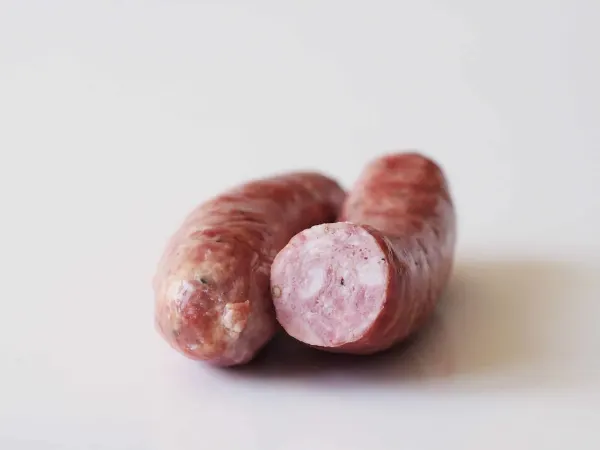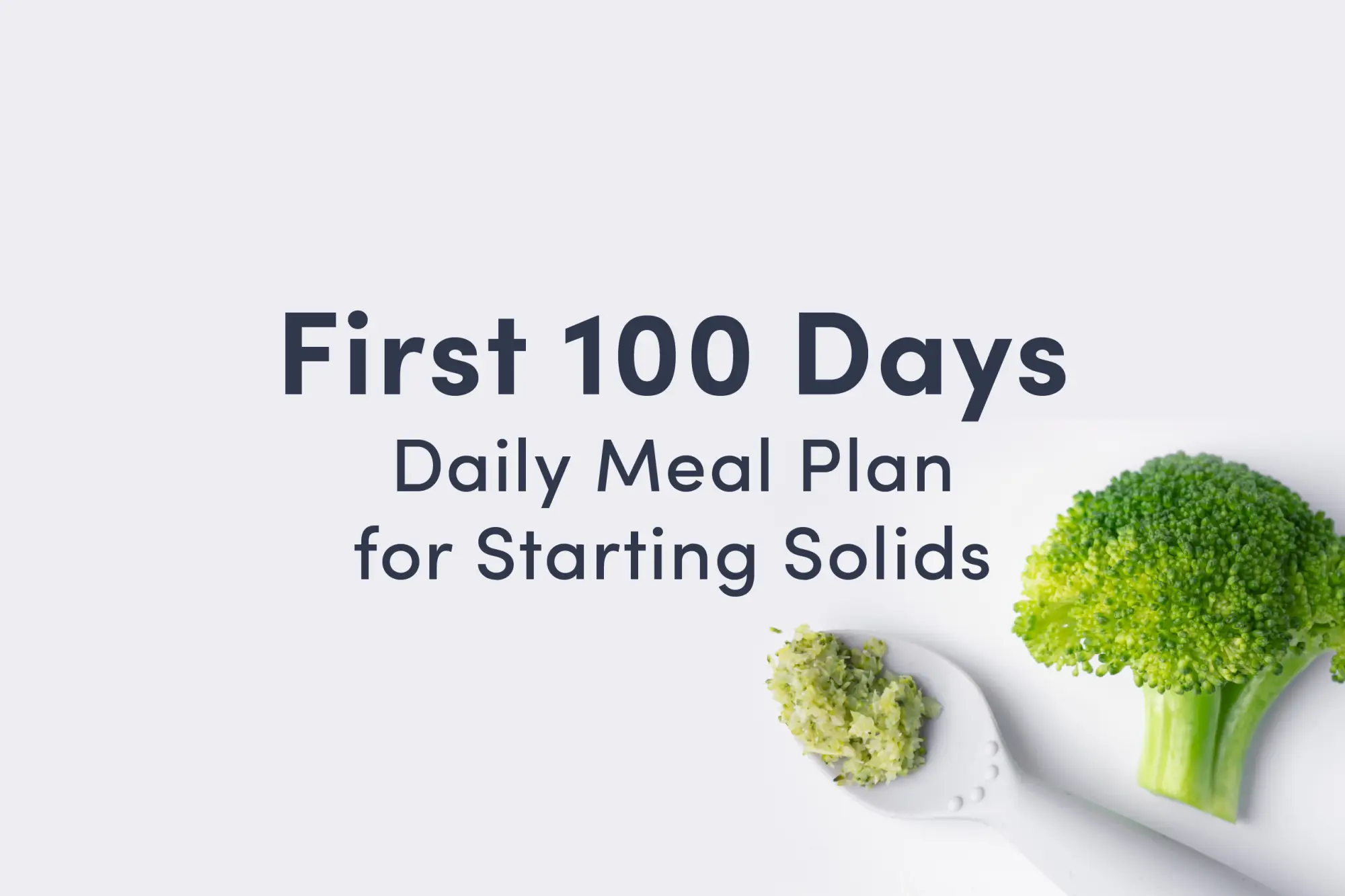Sausage
Meat
Age Suggestion
12 months
Iron-Rich
No
Common Allergen
No

When can babies eat sausage?
Sausage is best introduced after 12 months of age because it poses a high choking risk and it is often high in sodium and nitrates. If you want to share a small taste on occasion with baby and it doesn’t contain honey (a high-risk food for infant botulism), prepare the meat in a an-age appropriate way that minimizes the risk of choking.
Warning
Sausages are a choking hazard, so make sure to cut according to a child’s age and eating ability to reduce choking risk.
What are sausages made of?
Sausage is made by salting and forming ground-up meat into links, patties, or other shapes, a centuries-old preservation method. Nearly every culture in the world has its own version of sausage. Consequently, sausages are made of countless meats. There are pork sausages like bratwurst and chorizo; beef sausages like chả bò and hot dogs; fish and shellfish sausage like crawfish boudin, kamaboko, and soondae; mixed meat sausages like kaminwurz, makanek, and mutura; and hundreds more. There are also different preservation methods: firm, dry sausage is cured to the point that it does not require refrigeration, while soft, fresh sausage contains raw meat that must be cooked to order.
Videos
Is sausage healthy for babies?
It can be, depending on the preparation. Sausages are often high in sodium and nitrates, ingredients that should be minimized or avoided during a child’s first year of life. That said, they can also offer plenty of protein, fats, B-vitamins, choline, selenium, and zinc. After the first birthday, sausages may be served in moderation. Sausage and other processed red meats have received attention for their potential association with heart disease and cancer, although more research is needed. In general, try to minimize processed meats like sausages and aim for variety in the diet.
★Tip: When shopping for sausage, choose products labeled “reduced sodium.” Fresh sausages containing raw meat tend to be lower in sodium than cured or smoked varieties.
Is sausage a common choking hazard for babies?
Yes. Sausages are often cylindrical in shape and firm and springy in texture, qualities that heighten choking risk. In particular, smaller varieties like breakfast sausage links, vienna sausages, and “baby” sausages carry an even higher risk, as the sausage is closer in size to the diameter of a child’s airway. If you decide to serve sausage to baby, reduce the risk by removing the casing, crumbling the meat, and mixing the crumbles into a sauce or soft, scoopable food. After 12 months of age, remove the casing and cut the meat lengthwise into quartered sticks. As always, make sure you create a safe eating environment and stay within arm’s reach of baby at mealtime. For more information on choking, visit our section on gagging and choking and familiarize yourself with the list of common choking hazards.
Is sausage a common allergen?
No. Sausage is not a common food allergen, although it is possible to have allergies to ingredients in sausage, such as beef, pork, and others. Other ingredients that are common food allergens may be added to sausage, such as eggs, finned fish or shellfish, soy, or wheat, so make sure to read the label carefully.
Certain tick bites (mainly the Lone Star tick in the continental United States, but other ticks in different parts of the world), are associated with the development of an allergy to galactose-alpha-1, 3-galactose (“alpha gal”), a sugar which is present in all non-primate mammalian meat. This results in a delayed allergic reaction 3 to 8 hours after red meat is consumed. Some individuals with alpha gal allergy also react to small amounts of the sugar present in dairy products, gelatin, or organ tissues (such as liver) from mammals. Individuals with cat allergies may also have an increased risk of allergy to pork products, also known as pork-cat syndrome.
As with introducing any new food, start by serving a small quantity for the first few servings, and if there is no adverse reaction, gradually increase the quantity over future meals.
Does sausage need to be cooked to be safe to eat?
Generally, yes. Sausages made of raw ground beef, lamb, pork, or other red meats should be cooked to 160 F (71 C), while sausage made of raw poultry should be cooked to 165 F (74 C) to kill harmful bacteria. Importantly, even sausages marked as pre-cooked (hot dogs, breakfast sausages, vienna sausages) should be reheated to minimize the risk of foodborne illness.
Can sausage help babies poop?
No. In general, sausage is high in protein and fat and low in fiber, qualities that slow the processes of digestion and pooping. Remember that pooping patterns can vary significantly from baby to baby. If you have concerns about baby’s pooping and digestive function, talk to your pediatric healthcare provider.
How do you prepare sausage for babies with baby-led weaning?
Every baby develops on their own timeline, and the suggestions on how to cut or prepare particular foods are generalizations for a broad audience.
6 to 11 months old:
Try to avoid, since sausage poses a high risk of choking and typically contains lots of sodium and nitrates. If sausage is an important part of your family’s meals, offer a small taste on occasion. Sausages made of raw meat and pre-cooked sausages like hot dogs, breakfast sausages, and vienna sausages should be cooked before serving. Simply remove any casing if there is one, finely chop or break the meat into small crumbles, thoroughly cook the meat, and stir it into a soft, scoopable food like mashed vegetables, porridge, or yogurt. Do not serve dried sausage, jerky, or other forms of cured or smoked meat to babies because they are typically firm and hard to chew, which increases the risk of choking, and they are also typically high in sodium and nitrates.
12 to 17 months old:
For fresh sausage made of raw meat, remove the casing if there is one, thoroughly cook the meat, and break into crumbles or cut it into bite-sized pieces. Alternatively, keep the casing on and cut the sausage lengthwise into long quartered sticks. For cured, pre-cooked, or smoked products like andouille, breakfast sausage, hot dogs, or vienna sausage, cook the meat to reduce the risk of foodborne illness, then quarter the sausage lengthwise into long, thin sticks that the child can hold and practice taking bites from. Avoid cutting sausage into coins or other round shapes, as these can increase the risk of choking. Hold off on serving firm, dried sausages like salami, spanish chorizo, or summer sausage until at least 24 months of age.
18 to 24 months old:
Cut cooked sausages lengthwise into halves, or continue cutting into long, quartered sticks. Avoid serving sausage links cut into coins or rounds, as these shapes increase choking risk. You can also serve ground sausage that has been crumbled into sauces and other dishes, or sausage patties, either whole for the child to take bites from or broken into bite-size pieces. Sausages marked as “fresh” or “pre-cooked” must be cooked before serving, while smoked or cured forms of sausage do not need to be cooked.
24 months old+:
At this age, if a child has mature eating skills (not overstuffing their mouths, taking accurate bites, and chewing thoroughly before swallowing), they can likely practice eating a whole sausage, including in a bun if desired, although expect some mess as the child learns to deal with the challenging food. A whole sausage actually poses less choking risk than a sausage cut into rounds or small “coin” shaped pieces because the larger shape triggers the brain to take a bite and prepare the body to safely chew and swallow. When practicing eating sausage, make sure the child is seated and supervised in a safe eating environment. You can also serve firm, dried sausages like salami, spanish chorizo, or summer sausage. These do not need to be cooked, but they should be cut into long, thin sticks to minimize the choking risk and only offered to a toddler once the child has mature eating skills.
Sometime between 24 and 36 months of age, when you believe the child is able to follow directions and has had success in eating a variety of firm, hard-to-chew foods, you can offer rounds or coin-shaped slices of sausage. Offer one slice at a time and encourage the child to take a bite of the food with their front teeth before moving it to the side and chewing thoroughly. When practicing eating sausages, especially cut into rounds, make sure the child is seated and supervised in a safe eating environment.
Learn all about which foods are not safe for babies. Download our guide 25 Foods Never to Serve Your Baby.
Written by
Expert Tips Delivered to Your Inbox
Sign up for weekly tips, recipes and more!
The content offered on SolidStarts.com is for informational purposes only. Solidstarts is not engaged in rendering professional advice, whether medical or otherwise, to individual users or their children or families. No content on this site, regardless of date, should ever be used as a substitute for direct medical advice from your doctor or your medical or health professional, nutritionist, or expert in pediatric feeding and eating. By accessing the content on SolidStarts.com, you acknowledge and agree that you are accepting the responsibility for your child’s health and well-being. In return for providing you with an array of content “baby-led weaning” information, you waive any claims that you or your child may have as a result of utilizing the content on SolidStarts.com.








